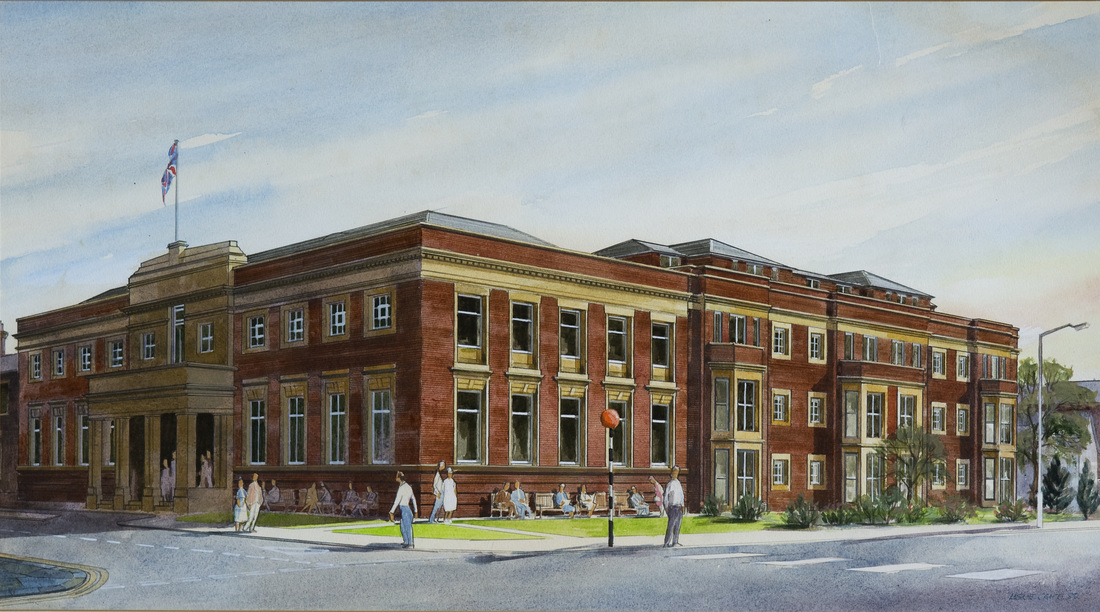Lytham Assembly Rooms 1986
|
Research by Marjorie Gregson
|

ARTIST
Leslie Cant was born in Glasgow on 1 May 1920, moving to Preston in his twenties and working as a set designer for the Salburg Players at Preston Hippodrome. (1) Prior to becoming a self-employed artist in 1983, he was office manager at the Building Design Partnership in Preston. (2) During his career as an artist he turned his talents to a range of disciplines, including perspective drawing and building design, sculpture, mosaic and murals, as well as lecturing. He enjoyed landscape painting, some of his favourite scenes being of the Lake District. Among his most treasured possessions was a five panel panoramic view of Preston painted from a vantage point on the 9th floor of Crystal House, next to the Harris Museum and Art Gallery. He spent much of 1999 drawing and painting this work, entitled Our Town, to mark the Millennium. He wanted to inspire a sense of belonging in the people of Preston. This work was included in Preston’s city bid in 2002 but never exhibited at the time. By permission of his widow, Dorothea, it was first shown at an exhibition entitled 'Leslie Cant: A Retrospective' in 2009. The exhibition, at the Museum of Lancashire, celebrated his work and showcased around 40 of his oil paintings and pastels depicting local Lancashire scenes including The River Brock, New Hall in Ribchester, Grimsargh House and The Old Bridge at Penwortham. Dorothea, nee Pilkington, and Leslie met in 1949 when she was working in a music shop in Fishergate, Preston and he as a scenery designer for the Salburg Players. She described their meeting, when he came in to hire a piano, as love at first sight. They met in the March and married in the August and had nearly 60 years together before he died of a stroke on 20 June 2007 at the age of 87. Dorothea said of his art, 'It was hard to say which of his paintings he was most proud of. He was proud of whatever he was painting at the moment'. (3) They had two children, Matthew and Gill. The centre piece of the panorama Our Town now hangs proudly behind the desk of Gill’s Estate Agency in Fulwood, Preston. Another local painting, Samlesbury Hall, near Preston, Lancashire is owned by Kelmarsh Hall in Northamptonshire. PAINTING The former Lytham Baths and Assembly Rooms are now owned by the Lytham Town Trust Limited. It has been the site of public buildings since 1795. The Baths, Theatre and Assembly Rooms were opened on 4 April 1863 and were originally operated by the Clifton family. Water for the baths was pumped from the sea by a “powerful steam engine” and filtered. There were small, individual baths as well as general swimming baths for both sexes, dressing, retiring, news and reading rooms and also a room for concerts and balls. During 1927-28 they were rebuilt by Lytham St Annes Corporation and given a palatial new frontage to Dicconson Terrace before being re-opened in June 1928. This frontage was retained when the rest of the baths was demolished in 1987. The major part of the building was converted into apartments and reopened in 1991. The Assembly Rooms were developed for community use and from 1991 have been administered by Lytham Town Trust Limited, a Registered Charity. The Assembly Rooms, Lytham was shown at the Lytham Heritage Centre in an exhibition entitled 'Local Relevance'. The text stated: 'Donated by the artist to the Mayor, John M Tavernor'. The Assembly Rooms are very much the main focus of this horizontal canvas. The impressive watercolour is obviously the work of a trained theatrical set designer with its perfect use of formal perspective and representational painting style, filling the frame in the shallow plane of the picture. This luminous view of the impressive building is architecturally detailed, the fall of light coming in from the right hand side. Although the corner of the building is on the left of the picture because the eye is caught by the red splash of the Belisha beacon in the centre of the painting the work appears perfectly balanced. The wispy clouds in the large expanse of sky, where the brushwork is free and energetic, lend a feeling of airiness and light, which together with the soft cobalt of the road in the foreground throw the building into dramatic relief. Cant uses a palette of soft siennas and ochres for the building itself, lit up by the bright green of the lawns and bushes. The figures around the building, for which he uses light summer colours, inhabit the picture rather than stand before it, emphasising the scale of these beautiful Assembly Rooms. As the painting was completed in 1986, before the new apartments were opened in 1991, it is possible the painting was done using architectural plans. DONOR John Tavernor held the rare distinction of having been mayor of both the former Lytham St Annes Council and Fylde Council, on which he served for 30 years from its inception until 2003. He was leader of Fylde Council from 1982-1994 and after being Lytham St Annes mayor in 1967-68 - when still only in his 30s - he was Fylde's first citizen in 1988-89 and deputy mayor in both 1980-81 and 1990-91. On retiring from the council, after losing his Ansdell seat in 2003, he was appointed to the ranks of honorary alderman, a title given to long-serving councillors in recognition of their outstanding contribution to the borough and their community. He died of coronavirus in 2020. |
REFERENCES
(1) Your Lancashire, 24 June 2009 (2) Live Fylde and Preston, Issue 17 (3) Lancashire Evening Post, 11 July 2007 openplaques.org/organisations/lytham_st-annes_civic_society www.bbc.co.uk/yourpaintings Media-Newswire.com Thank you to Dorothea and Gill Cant |

